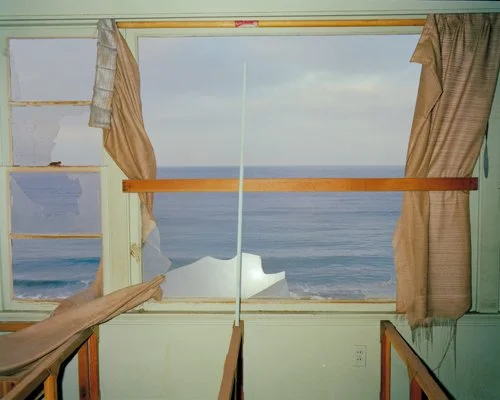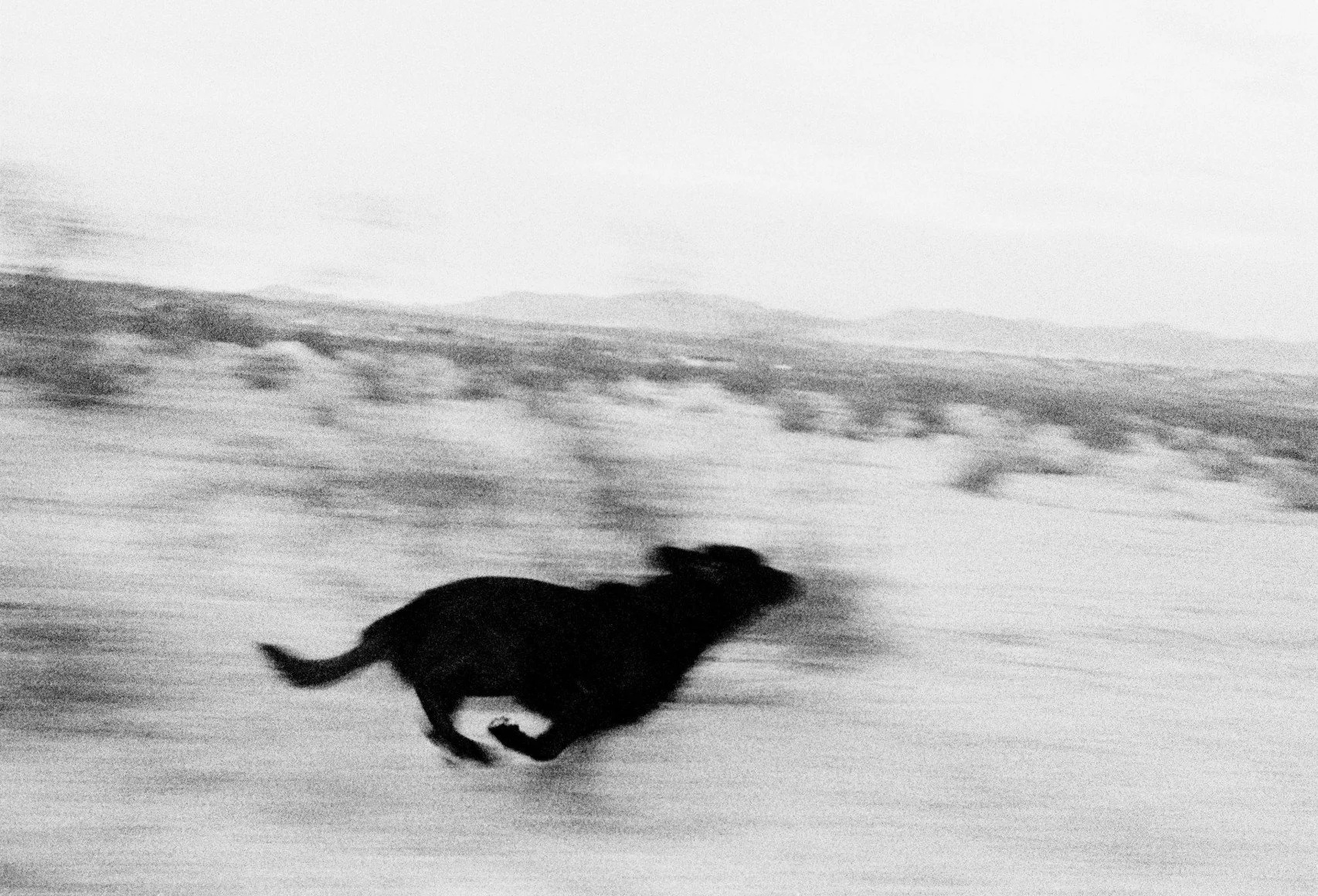A Chat with Artist John Divola
John Divola, a renowned American artist hailing from Los Angeles, California, has tirelessly cultivated a deeply compelling, lifelong narrative through his work. Born on January 1, 1949, Divola’s calling as an artist was already evident in his early fascination with the interplay of reality and perception.
After graduating with an MFA from the University of California, Los Angeles in 1974, Divola embarked on his artistic journey during a period of seismic shifts in the art world. An eloquent visual storyteller, Divola has always been acutely sensitive to his environment, using his camera as a tool to explore and decode the symbiotic relationship between human constructs and nature.
Known for his distinct approach to photography, Divola often manipulates the scenes he photographs, introducing elements of painting, performance, and sculpture. His works - a sublime crossroad of art forms - beautifully embrace the imperfections and transience inherent in the structures and landscapes we encounter.
Pioneering the intersection of photography and conceptual art, Divola is best recognized for his series such as "Zuma," where he captured the decaying interiors of a condemned beach house, imbuing the inanimate with haunting emotion. Each photograph is an evocative exploration of entropy, offering poignant insights into themes of abandonment, decay, and the passage of time.
Divola's work is a testament to his understanding of the coexistence of beauty and imperfection, the temporal and the eternal, the observed and the imagined. Despite having his works exhibited in major institutions worldwide such as the Los Angeles County Museum of Art and the New York Metropolitan Museum of Art, Divola remains as grounded as ever. He continues to live and work in Los Angeles, still entranced by the city’s unique rhythms and constantly seeking new stories to tell.
I spoke to John on a Friday's respite, my phone on speaker pressed to my ear as a Nison Altima blasted Ice Spice, and a couple fighting in the street brazenly cut through our conversation. I began this interview a bit off-kilter, intimidated by Divola’s accolades and my own unpreparedness. There is a certain academic diction that tends to make me stand up straighter and tense up for fear of being a lackluster conversational partner. I quickly came to learn that John’s descriptive language comes not from any level of pretension but from a deep understanding of his own methodology and a life engaged in dedicated practice. In a brief 12 minutes, he was able to talk deeply about his work, using my straightforward questions as a jumping point to impart deeper meanings behind his photographs.
Our conversation reaffirmed my presumption of Divola as an impassioned educator. For over three decades, he has been sharing his profound insights and extensive knowledge with students at the University of California, Riverside, where he serves as a distinguished Professor of Art.
© Courtesy John Divola
Gabe: All right. So first, I was just curious about your vision of space and these natural spaces versus created spaces and how you kind of conceptualize this idea of home. I'm interested in all these houses. If you could just touch a little bit on that.
John: So you need a little background to where I came from. So in the 1980s, I was doing a lot of work with kind of iconography. So it feels like, you know, kind of exhausted iconography of the sublime like I built tornadoes, house forms, and other things and placed them in the landscapes and photographed them.
Gabe: Explain iconography in the context you're talking about. Because I'm just thinking of religious iconography.
John: Something that’s symbolic instead of specific.
Gabe : Got it.
John: You know, like, if you make a cyclone out of papier maché.
Gabe: Right.
John: Or you make a house out of cardboard and you place it. So, you know, it's specific because it's a photograph. So it's a specific house made out of cardboard, but it's also an iconographic symbol for a house. Right?
Generic Sculpture / E
John Divola
1983-86
Gabe: Yes
John: Okay. So I was doing that all through the eighties. So I'm dealing with all these ideas about the sublime and iconography. And I thought, well, I ought to start dealing with this stuff literally instead of symbolically. I got a residency in Yosemite National Park, and I ended up making very grainy photographs of people wandering off into nature. And then from that I ended up doing a body of work, which is really kind of a portfolio, 20 photographs, which in each photograph was some kind of gesture of wanting to get outside of culture. And so one was the mountains, one was the desert, one was the city, one was the sea. These four ecologies in Southern California. And so in the mountains, it was people wandering off into nature, (and these are grainy black and white photographs) In the desert it was little isolated houses, the city was stray dogs, and the sea was little boats out at sea. So, when I was doing the black and white photographs of the little isolated houses, I got kind of seduced by the color out there and the life. So I went back and did the body of work that’s at Yancey Richardson of the isolated houses, which sort of carries over this idea of the kind of iconographic minimal signifier for the idea of habitation, of house, but it’s in the plain of the desert, you know?








Gabe: I guess to me all these spaces feel like non-place. Very transient. And you have these themes of isolation and leaving. Can you speak more to that? I know you have this series where you're just walking as far away from the camera as you can, am I correct?
As Far as I Could Get / R02F09, R02F04, Running #8
John Divola
1996/97
John: Yeah, running actually. Well, again I was interested initially in the idea of this kind of desire to be outside of culture or to get away. Of course, it's an ironic desire because you build your house in kind of the most remote place, but the line just kind of moves in front of you and you end up kind of converting nature into culture as you go, to implement ironic desire to be outside.
Gabe: Mmm
John: So, that’s one take. I mean, otherwise, it's formal, it’s visual, you know?
Gabe: What about the times of day that you choose to shoot these?
John: You know one likes late afternoon and earlier in the morning, but, you know, if it's mid-winter then you can photograph more. The broader spectrum of time. Southern California, a lot of times, is too bright in the middle of the day. It’s just deadly especially out in the desert. So, you know, in the winter, there's a broader time frame that kind of works. in the summer, in the Spring, in the Fall, you're kind of looking at a few hours of sunrise and sunset.
Gabe: And how are those in conversation with the interiors that you photograph where you have these abandoned places? I find those really odd and surreal. Logistically what does that look like to shoot? How do you identify some of these spaces?
Zuma Series (folder one) / b Zuma F
John Divola
1977
John: Well one of the reasons I was kind of out there earlier was that I was looking for abandoned places to photograph.
Gabe: Right.
John: So, I mean, there's that literal connection. Although in isolated houses, I made an effort to make the vast majority of them to look habitable. I didn't want them to look abandoned, necessarily.
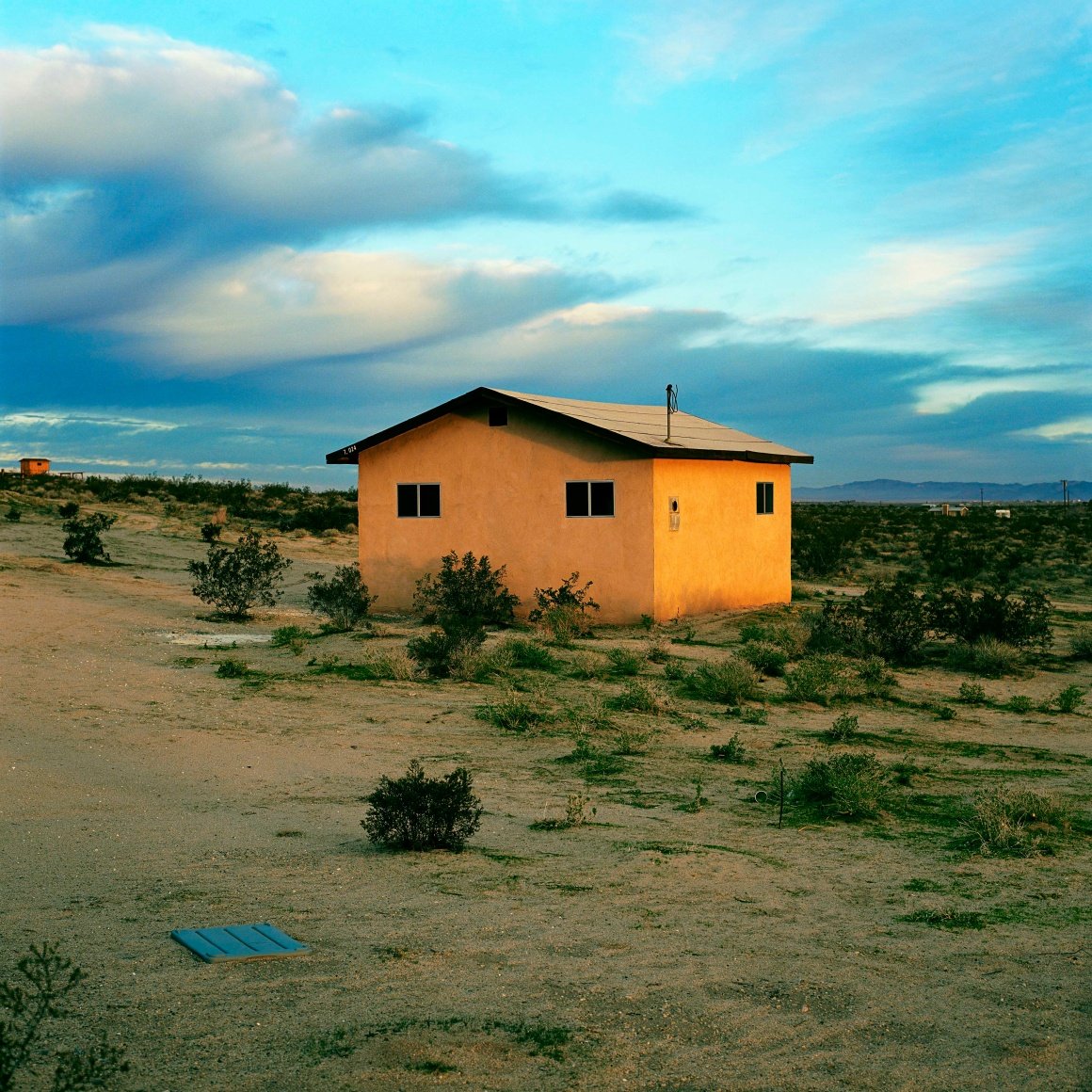

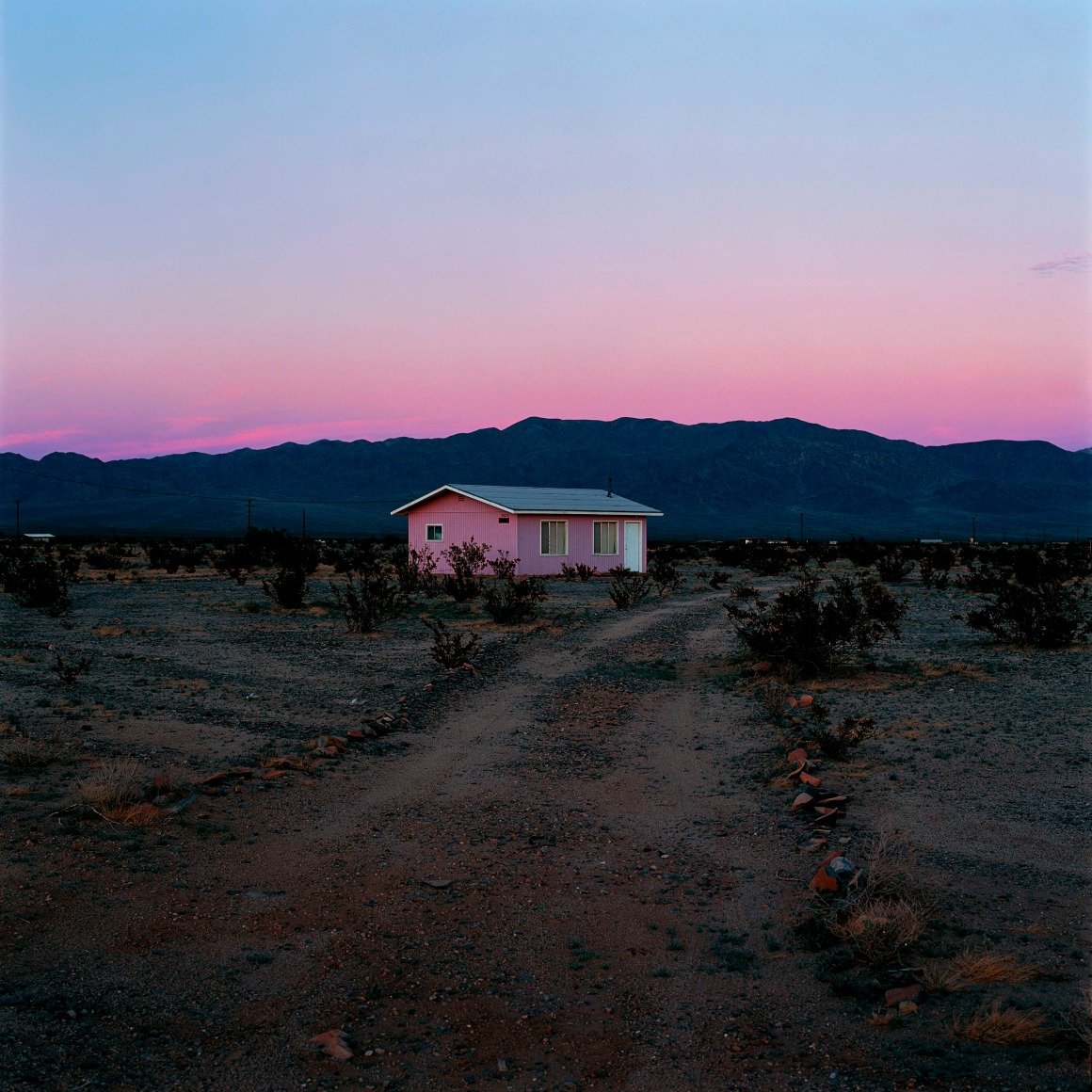
Gabe: Tell me about the dogs running for a second. I'm interested in how compressed those photos are. With what, a telephoto? I'm just interested in wha—
John: No, no It's a it's a normal lens.
Gabe: Is it? Like a 50? It looks compressed to me.
John: Yeah, shot on a 35mm camera.
Gabe: I guess I would call that still a little bit flat. Less dimensionality? What does that do to the photograph?
John Divola, D05F23 from the series Dogs Chasing My Car in the Desert, 1996-1998. Gelatin silver print, 20 x 24 inches.
John: Well, I mean, obviously, the longer the lenses the more compressed the space is going to be. The wider the lens the more—
Gabe: I guess, I mean thematically, what does it do for you? Why make that choice?
John: Why make that choice? Uhh.. I mean it was just.. the default.
Gabe: [Chuckles]
John: Just like running for the camera, 10 seconds on an analog camera is the default self-timer. So in some sense, it's just excepting the default on a camera. A 50mm on a 35mm is kind of the standard set. It’s not that I thought “Gee which lens should I use,” I started using that lens and it worked for me, and I continued using it. I think if it was longer, then that would have been a problem.
Gabe: Sure. I guess I'm just thinking of it in contrast to some of your GigaPan stuff. The tools you use seem so vastly different. Unlike a lot of photographers I look at, you know…it’s a Leica and 35mm for 40 years.
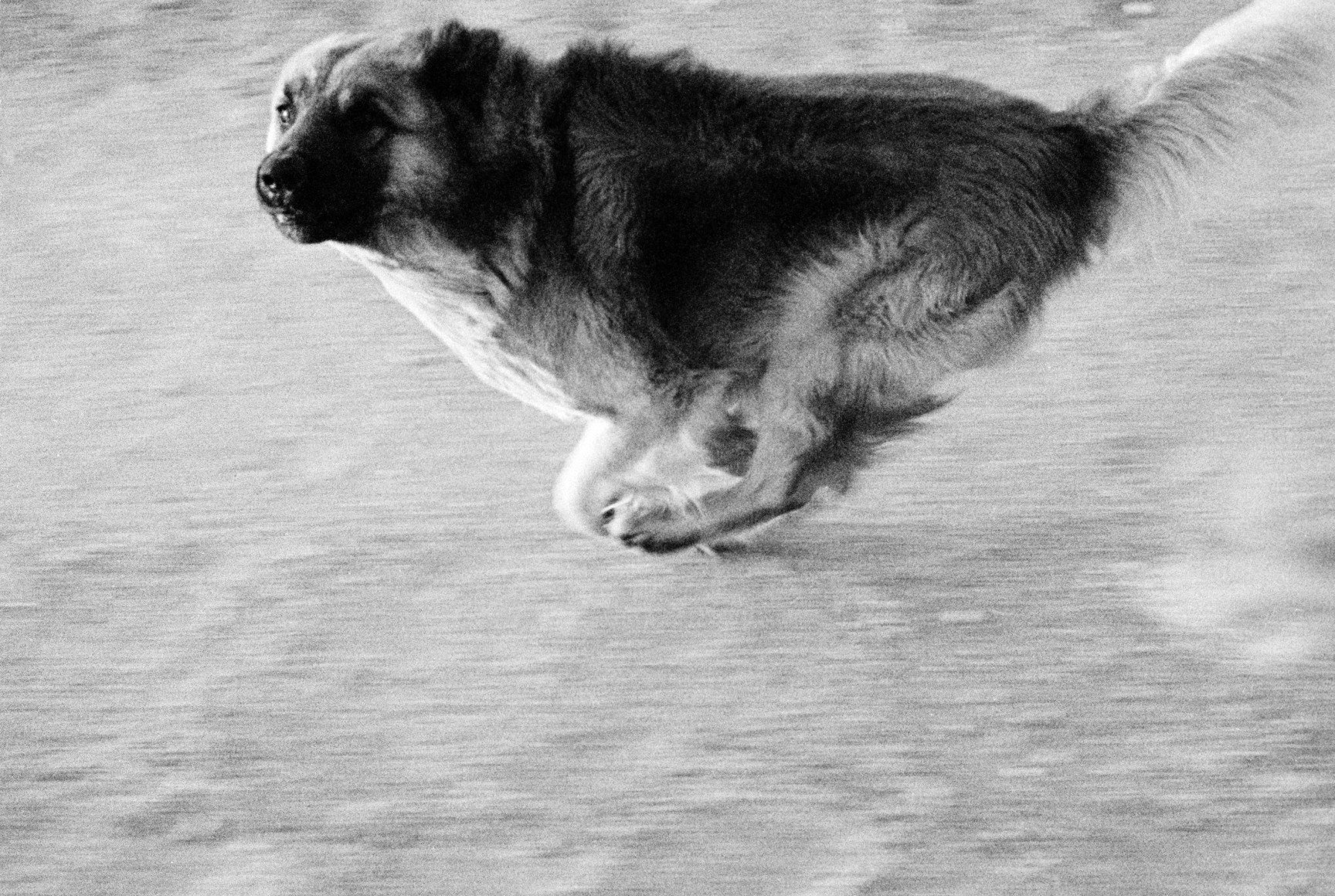

John: Right.
Gabe: And then maybe it’s digital. I'm just curious why you're exploring these different mediums and how that informs the work. Even if it is, I don't know, coincidental, the default.
John: Well what was more of a decision there was the film I used, a film called recording film which is incredibly grainy and chunky film.
Gabe: Got it.
John: That four landscape stuff I was describing. I wanted there to be a certain opacity to the image.
Gabe: Mmm.
John: A certain kind of industrial quality to it. They weren't seamless windows if you looked through, you could see the medium manifest in them. So I used that very grainy film which is the same film I used in the four landscapes I was describing. I used a point source enlarger to get the grain sharp.
Gabe : Got it
John: Or when I made pigment prints of them I used a drum scanner with the aperture set to the smallest setting which results right down to the grain particle. So in terms of technologically making choices, that was the more specific choice.
Gabe: Why is that tactility important to you?
John: Well, I got interested in the photographs being this kind of dead industrial thing. I just wanted the most ambitious possible iconography but this thing that’s kind of insistently dead and industrial. So I liked the collision of those two kind of ideas. No hand touches the photographic surface. Something that essentially pops out of a machine. And I like the collision of these kinds of more ambitious desires in relation to this kind of industrial enterprise, which is black and white and silver photography. It’s one of the highest manifestations of industrial expression.
Gabe: When you do projects like this does it feel like you keep creating and then they (the photographs) fall into these open-ended projects that are continuous, or is it really like you open the book and then you shut the book? You know, this is the page start, this is the page end. Then I'm moving on to something else.
John: No it’s not that quick. I mean, you come to some point of diminishing returns and you usually have more than one iron in the fire, other things you poked around at, you know, something else just becomes more compelling. So you switch over to that.
Gabe: Besides landscape and kind of … geography, what do you cite some of your primary inspirations as being?
John: I'm not sure about that question, I’m not sure what you’re asking.
Gabe: I guess.. you talk a lot about the land and this iconography, you know, being this inspiring force. I'm just interested in what artists you like and what artists have driven your craft.
John: Oh, you know, I like a lot of artists, but I don't know that they specifically inform what I do. I mean, Friedlander was important to me, Terrence Summers was important to me, Walker Evans not as directly, but important to me. I just saw a big Friedlander show back when mine was opening.
Gabe: The Joel Coen one?
John: Yeah.
Gabe: Yeah, that was interesting. I saw the one in New York, but I didn't see the one in San Francisco. I heard it was a lot bigger.
John: I didn't see the one in San Francisco either, I only saw the one in New York.
Gabe: How did you like that?
John: I loved it. I mean, there's a lot of work I hadn’t seen before. I don't care that much about Joel Coen and the sequencing.
Gabe: I'm talking to the director on Monday, so I’m trying to figure out why he (Joel Coen) picked the ones he did. That's a huge body of work to sort through.
John: Yeah, totally. Three things was there were lots of images I was not familiar with and they're printed beautifully.
Gabe: They looked so, so, so gorgeous.
John: You know, I had a real appreciation for that. And I just have a real appreciation for Friedlander. I mean, I think he made a real big step in what was going on, the social landscape.
Gabe: Agreed
John: He mutated it into something else
[Pause]
Gabe: Well…thanks, John, for talking with me!
John: You’re welcome
Gabe: I hope you found that interesting I just asked… well… what I could think of
John: Fair enough
Gabe: [Laughs]
Gabe: Alright well thanks for chatting
John: Take care
END
Check out Divola’s NYC show here through July 7th
Check out Lee Frielander’s NYC show here through July 28th









